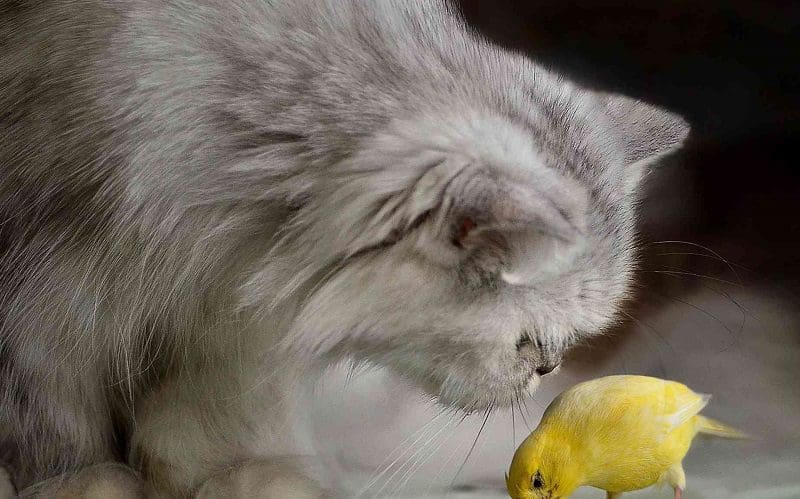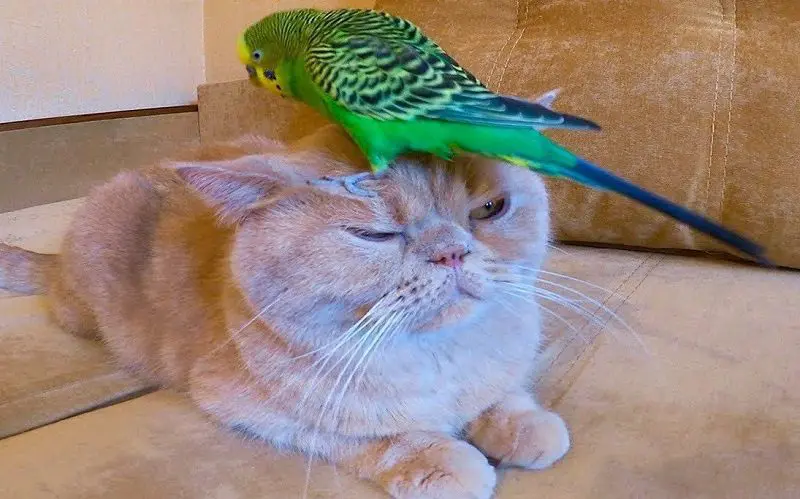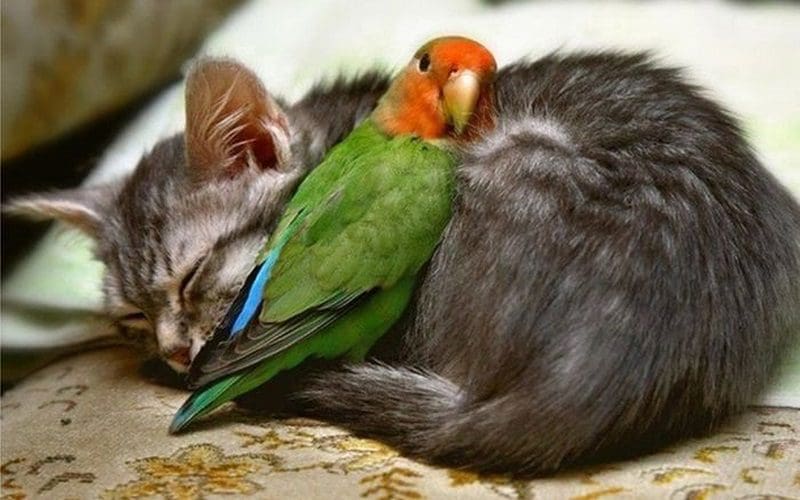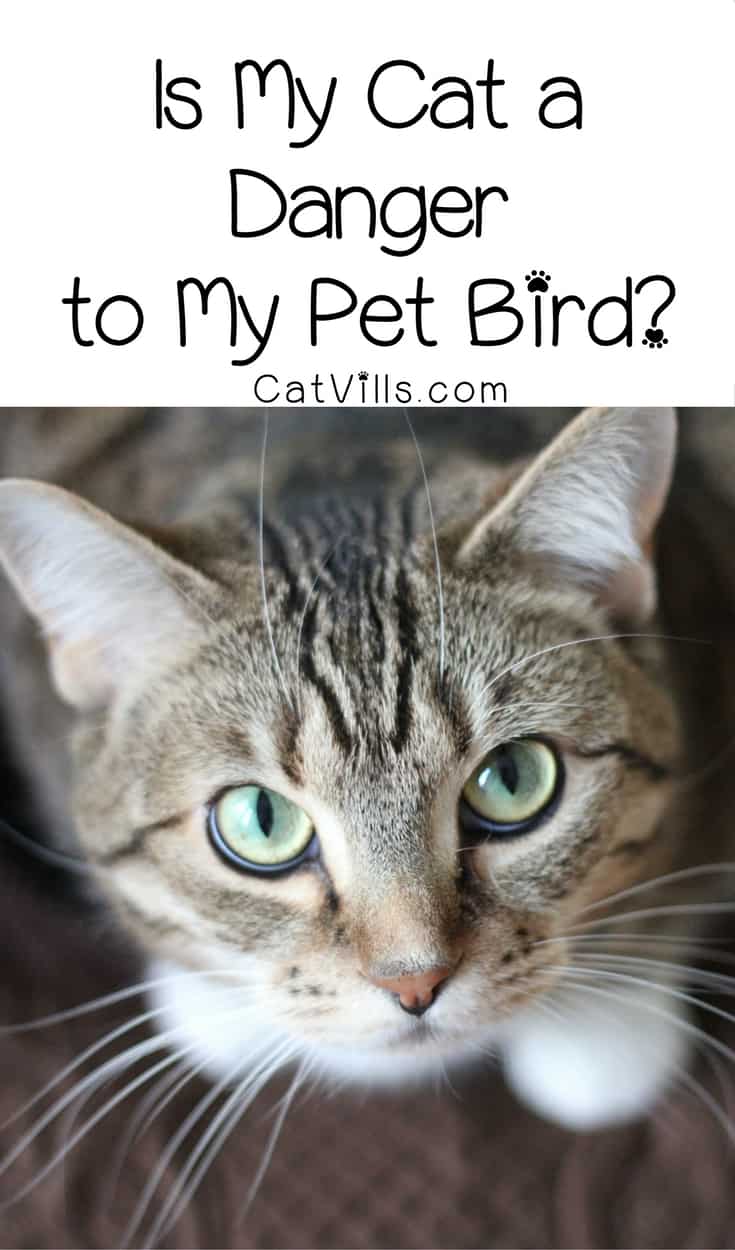Last Updated: 2 months ago
The clash between cats and birds is well-known. Just think of Sylvester the Cat and Tweety Bird!
According to the American Bird Conservancy’s 2014 State of the Birds Report, a whopping 2.4 billion birds in the US and 196 million birds in Canada are estimated to be killed by cats.
Cats have an instinct to hunt birds and small rodents, and even if they don’t kill them, a bite can lead to a deadly infection.
What’s a bird lover to do if they also love cats? Can cats and birds live together? Yes, they can! With careful attention and training, it is possible to keep both as pets.
Can Cats And Birds Live Together?

Creating a harmonious living environment for both cats and birds requires thoughtful consideration, understanding, and strategic planning.
Many pet enthusiasts wonder, “Can cats and birds live together peacefully?”
We explore the dynamics of fostering a positive relationship between these two diverse pets.
1. Compatibility in Behavior
Cats and birds can coexist when their individual behaviors align.
For instance, certain cat breeds may have a lower prey drive, making them less inclined to view birds as potential targets.
Cats that are more laid-back and less aggressive may be more suitable for living harmoniously with birds.
2. Early Socialization
Introducing a cat to birds at a young age through controlled interactions and positive reinforcement can foster an understanding that the birds are part of the household.
Early socialization helps shape the cat’s behavior and reduces the likelihood of aggressive tendencies towards birds.
3. Supervised Interaction
Ensuring that any interaction between cats and birds is supervised is crucial.
This supervision allows the cat owner to intervene if the cat displays predatory behavior.
Over time, consistent supervision can help reinforce positive behavior and discourage any attempts at aggression.
4. Providing Safe Spaces

Creating designated safe spaces for birds is essential.
This includes ensuring that the birds have secure cages or aviaries that are inaccessible to the cat.
Elevated perches and shelves can be installed to give birds a vantage point where they can observe their surroundings without feeling threatened.
5. Positive Reinforcement
Using positive reinforcement techniques can help shape the cat’s behavior positively.
Rewarding the cat for calm and non-aggressive behavior around the birds reinforces the idea that good behavior is rewarded, encouraging the cat to coexist peacefully.
6. Separate Living Areas
Maintaining separate living areas for cats and birds can be an effective strategy.
This physical separation ensures that the two pets have their own spaces, reducing the chances of accidental confrontations.
It also allows both pets to have a sense of security in their respective territories.
7. Proper Training
Basic training commands can be employed to teach cats to respect boundaries and understand cues related to interacting with birds.
Commands like “leave it” and “stay” can be helpful in controlling the cat’s behavior around birds.
8. Understanding Individual Pets

Recognizing and understanding the individual personalities of both the cat and the bird is crucial.
Some cats may have a more significant prey drive, making cohabitation challenging.
It’s essential to assess the temperament and behaviors of each pet to determine the feasibility of them living together.
9. Environmental Enrichment
Providing environmental enrichment for both cats and birds is vital.
This includes mental stimulation for the cat through toys, scratching posts, and climbing structures.
Similarly, birds benefit from a stimulating environment with toys, perches, and interactive elements within their living space.
10. Regular Veterinary Check-ups
Regular veterinary check-ups for both cats and birds are essential.
Monitoring their health ensures that any potential issues are addressed promptly and that the overall well-being of both pets is maintained.
While it is possible for cats and birds to live together harmoniously, careful consideration, supervision, and adherence to safety measures are crucial to creating a successful and safe multi-pet household.
Cat or Bird? Which Comes First?
Depending on which animal you have first, you will determine what to be on the lookout for as you look to add another to your family.
If you have a laid-back cat who doesn’t seem to have an active hunting instinct, you have a greater chance of successfully introducing most types of birds to your family.
If your cat is very playful and likes to “chirp” while sitting at the window watching birds, you ought to consider a smaller songbird such as a canary or parakeet who spends most of his time in a cage.
If you already have a bird and are looking to get a cat, it’s best to start with a kitten. An adult cat may already be set in his ways and could present more of a danger to your bird.
If you do have a larger bird like a parrot or cockatoo, be aware that the bird may bite the kitten, and that is also quite dangerous.
How to Help Cats and Birds Cohabitate

Until you are 100% confident that your cat will not hunt your bird, they should never be left in the same room together unsupervised.
As you train both your cat and bird, it may be possible for them to actually become friends.
The most important first line of defense is a sturdy, heavy cage. You need to be sure that the cat cannot knock over the cage, and an inexpensively made one just won’t do.
Also, the cage needs to be large enough that your bird can retreat from your cat’s reaching paws. Carefully observe how your cat behaves when in the room with your caged bird.
Is he constantly ready to pounce, or does he seem uninterested?
Depending on his reaction, you may need to spend more time simply having the cat in the same room as the caged bird before allowing the bird out of the cage.
Once it seems that your cat is less interested in your bird, close the door to the room and open the cage.
If the cat comes at the bird, even in a non-threatening manner, loudly say, “No!” or spritz the cat with a water bottle.
The ultimate goal is for both animals to more or less ignore each other, and short training sessions until that happens are best.
Don’t forget that while training, if you need to leave the room for any reason, your bird needs to go back in the cage.
Wrap-Up
The prospect of cats and birds cohabiting relies heavily on proactive measures, respect for each pet’s individual needs, and a commitment to their well-being.
While challenges may arise, the potential for peaceful coexistence exists with proper planning, supervision, and an appreciation for the unique qualities each pet brings to the household.
Even with all the hype, many families have successfully included both cats and birds.
Are you one of those families? What tips and tricks worked for you when integrating the new family member?
Resources:


Dr. Linda Simon MVB MRCVS is a locum veterinary surgeon who has worked in London for the past 8 years. She graduated top of her class in small animal medicine from UCD, Dublin. She is currently a member of the Royal College of Veterinary Surgeons. Linda is the resident vet for Woman magazine and a frequent contributor to People’s Friend Magazine, the Dogzone website, Vet Help Direct and Wag! Linda also writes content for the CVS veterinary group, Vetwriter and a number of other establishments.
